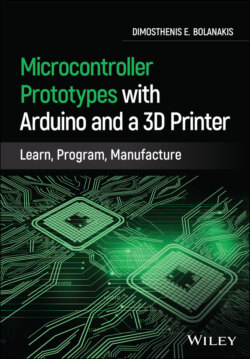Microcontroller Prototypes with Arduino and a 3D Printer

Реклама. ООО «ЛитРес», ИНН: 7719571260.
Оглавление
Dimosthenis E. Bolanakis. Microcontroller Prototypes with Arduino and a 3D Printer
Table of Contents
List of Tables
List of Illustrations
Guide
Pages
Microcontroller Prototypes with Arduino and a 3D Printer. Learn, Program, Manufacture
About the Author
List of Figures
List of Tables
Preface
Acknowledgments
Abbreviations. Greek‐English Alphabet:
English Alphabet:
Syllabus
1 The Art of Embedded Computers
Overview of Embedded Computers and Their Interdisciplinarity
Computer vs. Embedded Computer Programming and Application Development
Group 1: Programmable Logic Devices
Group 2: Reconfigurable Computers
Group 3: Microcomputers
Group 4: Single‐Board Computers
Group 5: Mobile Computing Devices
TPACK Analysis Toward Teaching and Learning Microcomputers
TPACK Analysis of the Interdisciplinary Microcontroller Technology
Content Knowledge (The What)
Technology Knowledge (The Why)
Pedagogical Knowledge (The How)
From Computational Thinking (CT) to Micro‐CT (μCT)
CT Requirement and Embedded Computers
Microcomputers and Abstraction Process
The μCT Concept: An Onion Learning Framework
“Transparent” Teaching Methods
The Impact of Microcontroller Technology on the Maker Industry
Hardware Advancement in μC Technology
Software Advancement in μC Technology
The Impact of Arduino on the μC Community
Where Is Creativity in Embedded Computing Devices Hidden?
Creativity in Mobile Computing Devices: Travel Light, Innovate Readily!
Communication with the Outside World: Sensors, Actuators, and Interfaces
Conclusion
Notes
2 Embedded Programming with Arduino
Number Representation and Special‐Function Codes
Arduino and C Common Language Reference
Working with Data (Variables, Constants, and Arrays)
Arduino UART Interface to the Outside World (Printing Data)
Arduino Ex.2–1
Arduino Ex.2–2
Program Flow of Control (Arithmetic and Bitwise Operations)
Arduino UART Interface (Flow of Control and Arithmetic/Bitwise Examples)
Arduino Ex.2–3
Arduino Ex.2–4
Arduino Ex.2–5
Arduino Ex.2–6
Arduino Ex.2–7
Code Decomposition (Functions and Directives)
Arduino Ex.2–8
Conclusion
Problem 2–1 (Data Output from the μC Device: Datatypes and Bytes Reserved by the hw)
Problem 2–2 (Data Output from the μC Device: Logical Operators in Control Flow)
Problem 2–3 (Data Input to the μC Device: Arithmetic and Bitwise Operations)
Problem 2–4 (Code Decomposition)
Notes
3 Hardware Interface with the Outside World
Digital Pin Interface
Arduino Ex.3.1
Arduino Ex.3.2
Arduino Ex.3.3
Arduino Ex.3.4
Arduino Ex.3.5
Analog Pin Interface
Arduino Ex.3.6
Arduino Ex.3.7
Interrupt Pin Interface
Arduino Ex.3.8
UART Serial Interface
Arduino Ex.3.9
Arduino Ex.3.10
Arduino Ex.3.11
SPI Serial Interface
Arduino Ex.3.12
Arduino Ex.3.13
Arduino Ex.3.14
Arduino Ex.3.15
I2C Serial Interface
Arduino Ex.3.16
Arduino Ex.3.17
Arduino Ex.3.18
Arduino Ex.3.19
Conclusion
Problem 3.1 (Data Input and Output to/from the μC Using Push‐Button and LED IO Units)
Problem 3.2 (PWM)
Problem 3.3 (UART, SPI, I2C)
Notes
4 Sensors and Data Acquisition
Environmental Measurements with Arduino Uno
Arduino Ex.4–1
DAQ Accompanying Software of the Ex.4–1
DAQ Accompanying Software with Graphical Monitoring Feature Via gnuplot
Arduino Ex.4–2
Orientation, Motion, and Gesture Detection with Teensy 3.2
Arduino Ex.4–3
Arduino Ex.4–4
Arduino Ex.4–5
Arduino Ex.4–6
DAQ Accompanying Software for Orientation, Motion, and Gesture Detection with gnuplot
Real Time Monitoring with Open GL
Distance Detection and 1D Gesture Recognition with TinyZero
Arduino Ex.4–7
Arduino Ex.4–8
DAQ Accompanying Software for Distance Measurements
Color Sensing and Wireless Monitoring with Micro:bit
Arduino Ex.4–9
Arduino Ex.4–10
Open GL Example Applying to RGB Sensing
Arduino Ex.4–11
Conclusion
Problem 4–1 (Data Acquisition of Atmospheric Pressure)
Problem 4–2 (Fusion of Linear Acceleration and Barometric Altitude)
Problem 4–3 (1D Gesture Recognition)
Problem 4–4 (Color Sensing)
Notes
5 Tinkering and Prototyping with 3D Printing Technology
Tinkering with a Low‐cost RC Car
Arduino Ex.5.1
Arduino Ex.5.2
A Prototype Interactive Game for Sensory Play
Hardware Boards of the Prototype System
Assembly Process of the 3D Printed Parts of the System's Enclosure
Firmware Code Design and User Instructions
Arduino Ex.5.3
Arduino Ex.5.4
Arduino Ex.5.5
Arduino Ex.5.6
3D Printing
Modeling 3D Objects with FreeCAD Software
Preparing the 3D Prints with Ultimaker Cura Software
3D Printing with Prima Creator P120
Presentation of the Rest 3D Models of the Prototype Interactive Game
PrototypeB (Modeling the battery.stl Part)
PrototypeC (Modeling the booster.stl Part)
PrototypeD (Modeling the speaker.stl Part)
PrototypeE (Modeling the cover.stl Part)
PrototypeF (Modeling the button.stl Part)
PrototypeG (Modeling the sensor.stl Part)
PrototypeH (Modeling the front.stl Part)
Conclusion
Problem 5.1 (Tinkering with a Low‐cost RC Car)
Problem 5.2 (A Prototype Interactive Game for Sensory Play)
Problem 5.3 (A Prototype Interactive Game for Sensory Play)
Problem 5.4 (A Prototype Interactive Game for Sensory Play)
Problem 5.5 (3D Printing)
Notes
References
Index. a
b
c
d
e
f
g
h
i
k
l
m
n
o
p
q
r
s
t
u
v
w
WILEY END USER LICENSE AGREEMENT
Отрывок из книги
Dimosthenis E. Bolanakis
Department of Air Force Science
.....
Chapter 4 applies to sensors (used in microcontroller projects) and to the data acquisition process. Because modern sensor devices constantly pave the way for creativity and innovation in embedded solutions, this chapter aims to inspire the interest and curiosity of the reader, through examples that apply to the detection of orientation, motion, gesture, distance, and color sensing. The examples are implemented with some of the most popular and contemporary boards in the worldwide market, that is, Teensy 3.2, TinyZero, and Micro:bit. The examples are designed in a way so that they direct readers in achieving simplicity in design. The process of interfacing with mobile phone through Bluetooth technology is also explored. Once again, the explanatory figures of the chapter are conducted with particular devotion in order to help readers achieve a deep understanding of the explored topics.
Chapter 5 applies to the tinkering practices of μC‐based electronic products using Arduino‐related hardware and software tools, as well as prototyping techniques using 3D printing technology. Having dealt with the theoretical and practical topics covered by the previous chapters (mainly by Chapters 2–4), the reader should be ready to proceed to practices related to real‐world projects, as those covered by this particular chapter. Creativity and simplicity in design are two of main features that are addressed by the carefully thought examples of this chapter.
.....